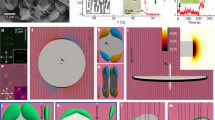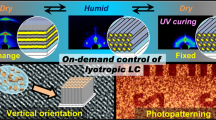Abstract
Liquid crystals are often combined with polymers to influence the liquid crystals' orientation and mechanical properties, but at the expense of reorientation speed or uniformity of alignment. We introduce a new method to create self-assembled nematic liquid-crystal gels using an ABA triblock copolymer with a side-group liquid-crystalline midblock and liquid-crystal-phobic endblocks. In contrast to in situ polymerized networks, these physical gels are homogeneous systems with a solubilized polymer network giving them exceptional optical uniformity and well-defined crosslink density. Furthermore, the unusually high-molecular-weight polymers used allow gels to form at lower concentrations than previously accessible. This enables these gels to be aligned by surface anchoring, shear, or magnetic fields. The high content of small-molecule liquid crystal (≥95%) allows access to a regime of fast reorientation dynamics.
This is a preview of subscription content, access via your institution
Access options
Subscribe to this journal
Receive 12 print issues and online access
$259.00 per year
only $21.58 per issue
Buy this article
- Purchase on Springer Link
- Instant access to full article PDF
Prices may be subject to local taxes which are calculated during checkout






Similar content being viewed by others
References
de Gennes, P.-G. The Physics of Liquid Crystals (Clarendon, Oxford, 1993).
Assfalg, N. & Finkelmann, H. A smectic A liquid single crystal elastomer (LSCE): Phase behavior and mechanical anisotropy. Macromol. Chem. Phys. 202, 794–800 (2001).
Sanger, J., Gronski, W., Leist, H. & Wiesner, U. Preparation of a liquid single-crystal triblock copolymer by shear. Macromolecules 30, 7621–7623 (1997).
Finkelmann, H., Kock, H.-J. & Rehage, G. Investigations on liquid crystalline polysiloxanes 3. Liquid crystalline elastomers — a new type of liquid crystalline material. Makromol. Chem. Rapid Commun. 2, 317–322 (1981).
Craighead, H.G., Cheng, J. & Hackwood, S. New display based on electrically induced index matching in an inhomogeneous medium. Appl. Phys. Lett. 40, 22–24 (1982).
Huitema, H.E.A. et al. Plastic transistors in active-matrix displays. Nature 414, 599 (2001).
Coates, D. Polymer-dispersed liquid crystals. J. Mater. Chem. 5, 2063–2072 (1995).
Bouteiller, L. & Le Barny, P. Polymer-dispersed liquid crystals: Preparation, operation, and application. Liq. Cryst. 21, 157–174 (1996).
Dierking, I. Polymer network-stabilized liquid crystals. Adv. Mater. 12, 167–181 (2000).
Guymon, C.A. et al. Effects of monomer structure on their organization and polymerization in a smectic liquid crystal. Science 275, 57–59 (1997).
Hikmet, R.A.M. & Kemperman, H. Electrically switchable mirrors and optical components made from liquid-crystal gels. Nature 392, 476–479 (1998).
Hikmet, R.A.M. Electrically induced light-scattering from anisotropic gels. J. Appl. Phys. 68, 4406–4412 (1990).
Hikmet, R.A.M. Anisotropic networks and gels formed by photopolymerisation in the ferroelectric state. J. Mater. Chem. 9, 1921–1932 (1999).
Terentjev, E.M., Warner, M., Meyer, R.B. & Yamamoto, J. Electromechanical Fredericks effects in nematic gels. Phys. Rev. E 60, 1872–1879 (1999).
Chang, C.C., Chien, L.C. & Meyer, R.B. Electro-optical study of nematic elastomer gels. Phys. Rev. E 56, 595–599 (1997).
Kihara, H., Kishi, R., Miura, T., Kato, T. & Ichijo, H. Phase behavior of liquid-crystalline copolymer/liquid crystal blends. Polymer 42, 1177–1182 (2001).
Chang, M.C. et al. Phase transitions in mixtures of a side-on-side chain liquid crystalline polymer and low molar mass nematic liquid crystals. Liq. Cryst. 25, 733–744 (1998).
Sanger, J., Tefehne, C., Lay, R. & Gronski, W. A simplified procedure of anionic polymerization of styrene and dienes using 4,5-methylenephenanthrene as an indicator. Polym. Bull. 36, 19–26 (1996).
Ojima, I. et al. Reduction of carbonyl-compounds via hydrosilylation.1. Hydrosilylation of carbonyl-compounds catalyzed by tris(triphenylphosphine)chlororhodium. J. Organometall. Chem. 94, 449–461 (1975).
Hempenius, M.A., Lammertink, R.G.H. & Vancso, G.J. Well-defined side-chain liquid-crystalline polysiloxanes. Macromol. Rapid Commun. 17, 299–303 (1996).
Moment, A., Miranda, R. & Hammond, P.T. Synthesis of polystyrene-polysiloxane side-chain liquid crystalline block copolymers. Macromol. Rapid Commun. 19, 573–579 (1998).
Almdal, K., Dyre, J., Hvidt, S. & Kramer, O. What is a gel? Makromol Chem. Macromol. Symp. 76, 49–51 (1993).
Li, M.H., Brulet, A., Davidson, P., Keller, P. & Cotton, J.P. Observation of hairpin defects in a nematic main-chain polyester. Phys. Rev. Lett. 70, 2297–2300 (1993).
Lecommandoux, S., Achard, M.F., Hardouin, F., Brulet, A. & Cotton, J.P. Are nematic side-on polymers totally extended? A SANS study. Liq. Cryst. 22, 549–555 (1997).
Leroux, N., Keller, P., Achard, M.F., Noirez, L. & Hardouin, F. Small-angle neutron-scattering experiments on side-on fixed liquid-crystal polyacrylates. J. Phys. II 3, 1289–1296 (1993).
Finkelmann, H., Kim, S.T., Munoz, A., Palffy-Muhoray, P. & Taheri, B. Tunable mirrorless lasing in cholesteric liquid crystalline elastomers. Adv. Mater. 13, 1069–1072 (2001).
Van Horn, B.L. & Winter, H.H. Analysis of the conoscopic measurement for uniaxial liquid-crystal tilt angles. Appl. Optics 40, 2089–2094 (2001).
Khoo, I.-C. & Wu, S.T. Optics and Nonlinear Optics of Liquid Crystals (World Scientific, Singapore, 1993).
Skarp, K., Lagerwall, S.T. & Stebler, B. Measurements of hydrodynamic parameters for nematic 5CB. Mol. Cryst. Liq. Cryst. 60, 215–236 (1980).
Yang, D.K., Chien, L.C. & Doane, J.W. Cholesteric liquid-crystal polymer dispersion for haze-free light shutters. Appl. Phys.Lett. 60, 3102–3104 (1992).
Wu, S.T. & Yang, D.K. Reflective Liquid Crystal Displays (ed. Lowe, A.C.) (Wiley, New York, 2001).
Walba, D.M. Fast ferroelectric liquid-crystal electrooptics. Science 270, 250–251 (1995).
Wu, S.T., Wang, Q.H., Kempe, M.D. & Kornfield, J.A. Perdeuterated cyanobiphenyl liquid crystals for infrared applications. J. Appl. Phys. 92, 7146–7148 (2002).
Zimmermann, H. Specifically deuteriated intermediates for the synthesis of liquid crystals and liquid-crystalline polymers. Liq. Cryst. 4, 591–618 (1989).
Acknowledgements
The authors acknowledge financial support from the United States Air Force Office of Scientific Research Liquid Crystal Multidisciplinary Research Program of the University Research Initiative (LC-MURI) (f4962-97-1-0014), the ARCS Foundation, the United States National Science Foundation Department of Materials Research (DMR-0216491), and the United States National Defense Science and Engineering Graduate (NDSEG) Fellowship. We would like to thank Steven Smith of Proctor and Gamble for providing us with 1,2-polybutadiene samples.
Author information
Authors and Affiliations
Corresponding author
Ethics declarations
Competing interests
The authors declare no competing financial interests.
Rights and permissions
About this article
Cite this article
Kempe, M., Scruggs, N., Verduzco, R. et al. Self-assembled liquid-crystalline gels designed from the bottom up. Nature Mater 3, 177–182 (2004). https://doi.org/10.1038/nmat1074
Received:
Accepted:
Published:
Issue Date:
DOI: https://doi.org/10.1038/nmat1074
This article is cited by
-
Morphing in nature and beyond: a review of natural and synthetic shape-changing materials and mechanisms
Journal of Materials Science (2016)
-
Liquid crystal gels cross-linked with 1,3,5-tris-(ω-methacryloyloxyalkyloxy)benzenes
Colloid and Polymer Science (2011)
-
Self-assembled block copolymers: Bulk to thin film
Macromolecular Research (2008)
-
Bridging the experiment–theory gap
Nature Materials (2004)



